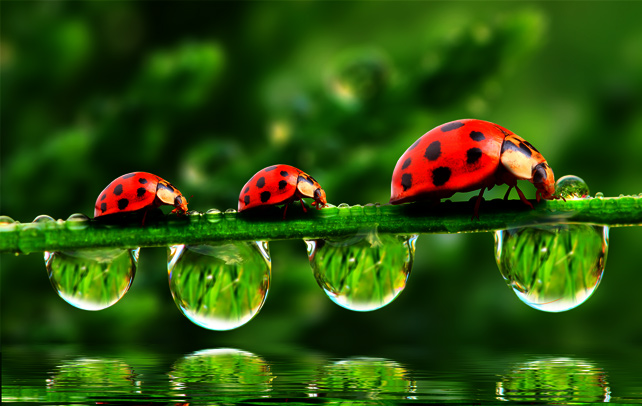Interesting Facts About Ladybugs

Considered to be the king of insects, the red coloured and black spotted ladybug, commands a great respect in many of the international cultures. It will come as a surprise to many that not all the ladybugs are females, and scientifically speaking they are not even bugs; they are beetles. The bright colours give these insects a distinct and almost royal look; these are one of the most beautiful of the insect families. Interestingly, at the time of birth, the ladybugs are black in colour. Also, there are almost 5000 types of ladybugs which are found in different locations of the world. These insects are common in almost all parts of world. Ladybugs prosper in warm climate, and hence are mostly seen during the season of spring. In the winter season, these insects go for hibernation. Though these are social insects and live in swarms, but they seldom cause any destruction to crops or property. Here are some interesting facts about these beautiful insects.
Fast Facts
Scientific Name: Coccinella magnifica
Kingdom: Animalia
Phylum: Arthropoda
Class: Insecta
Order: Coleoptera
Genus: Coccinella
Family: Coccinellidae
Species: approximately 5000
Size: 1 to 10mm (depending upon the species)
Diet: omnivore, aphids, Scale Insects, Mealybugs and Mites
Natural Habitat: trees, shrubs, fields, beaches and homes
Age: 2 – 3 years
Gestation Period: 4 – 7 weeks
Number of Offspring: 1 – 2 (depending upon the species)
Interesting Facts About Ladybugs
- A bug is an insect which uses its mouth to suck food whereas ladybugs chew their food with the help of pincers inside their mouth. Hence, these are beetles by description.
- There is a myth which goes back to the medieval Europe. In the middle ages crops in Europe were plagued by pests and then the peasants started to pray to the Virgin Mary. As a result of their prayers, ladybugs appeared in the fields and ate all the pests, resulting in crops to prosper. From that time, people started considering these beetles sacred, and thus began calling them lady beetles after Virgin Lady.
- A ladybug’s blood is both toxic and rank. Whenever a ladybug is teased then it excretes a yellowish, foul smelling fluid, which is toxic for a number of small animals. This fluid seeps from the leg joints of the ladybug. Hence, the ladybug can rescue itself from the predators as they are repelled by the toxic and smelly liquid.
- These bugs have slowly developed the colour of their shells to red and black. The scientific reason behind this is that tiny predators, like small birds try to keep away from food, especially if it is coloured, black, or vibrant red. This technique is called aposematia, where colour is used as a signal to the toxic contents.
- Ladybugs eat soft bodied and small insects which are commonly found in farms, forests, and household; hence serving as a potential predator of plant pests. Peasants are really fond of these small and vibrant insects because they know that these are beneficial for their crops. These beetles devour almost 50 aphids per day.
- The larvae of ladybugs resemble small crocodiles: their stomach is small, but pointed; their bodies are spiny; and their legs protrude from the side of their bodies. The period of these ladybirds as larvae is about a month, and during this period, they can consume hundreds of aphids or other insects.
- The larvae eggs are highly nutritious and rich in protein. A ladybug can lay a large number of fertilized and unfertilized eggs. The unfertilized eggs are the primary source of food for the fertilized larvae.
- These insects hibernate during winters because they prosper only in warm temperatures. With a gradual fall in temperature, ladybugs try to hide themselves in the barks of the trees and under the leaves. These shelters may house thousands of these winged insects at one place.
- During winters, these insects move towards warmer locations; such as, a house or a cave. They may cause nuisance in houses because of their large number, but they do not cause any damage to the property. Convergent ladybugs gather in the mountains in such numbers that collectors can scoop them up with a bucket.
- During times when the food is scarce, the ladybugs take the most drastic measure to survive and they turn cannibal and eat the sickly or old bugs, if really necessary. New ladybugs which evolve from larvae to beetles have soft shells and are easy prey for more matured beetles.
- The spots at the back of the shells of ladybugs are just for display and do not serve any purpose apart from scaring off the predators.
- Ladybugs are found in many different colours apart from red and black. These are colourful and can have colours like pink, yellow, and more.
- A ladybug beats its wings about 5100 times a minute or about 85 beats a second when it flies.









